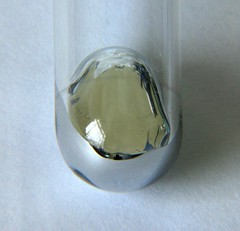Mercury, also quicksilver or hydrargyrum, is a chemical element with the symbol Hg (Latinized Greek: hydrargyrum, from "hydr-" meaning watery or runny and "argyros" meaning silver) and atomic number 80.
A heavy, silvery d-block metal, mercury is one of five metallic chemical elements that are liquid at or near room temperature and pressure, says Wikipedia.
Mercury occurs in deposits throughout the world mostly as cinnabar (mercuric sulfide), which is the source of the red pigment vermilion, and is mostly obtained by reduction from cinnabar. Cinnabar is highly toxic by ingestion or inhalation of the dust.
Mercury is used in thermometers, barometers, manometers, sphygmomanometers, float valves, and other scientific apparatus.
Mercury was found in Egyptian tombs that date from 1500 BC.[15] It was also known to the ancient Chinese.[16] In China and Tibet, mercury use was thought to prolong life, heal fractures, and maintain generally good health. One of China's emperors, Qín Shǐ Huáng Dì — allegedly buried in a tomb that contained rivers of flowing mercury on a model of the land he ruled, representative of the rivers of China — was killed by drinking a mercury and powdered jade mixture (causing liver failure, poisoning, and brain death) intended to give him eternal life.[17][18]
The ancient Greeks used mercury in ointments; the ancient Egyptians and the Romans used it in cosmetics which sometimes deformed the face. By 500 BC mercury was used to make amalgams with other metals.[19] The Indian word for alchemy is Rasavātam which means "the way of mercury".[20]
Alchemists thought of mercury as the First Matter from which all metals were formed. They believed that different metals could be produced by varying the quality and quantity of sulfur contained within the mercury. The purest of these was gold, and mercury was called for in attempts at the transmutation of base (or impure) metals into gold, which was the goal of many alchemists.[21]
skip to main |
skip to sidebar
For students and parents who love education and exploration of the social sciences . . .
Search This Blog
Followers
Blog Archive
-
▼
2010
(346)
-
▼
April
(32)
- Hard Working Substitute Wei: "Not One Less" Wei Essay
- A quiz on the Odyssey of a Chinese Teen in Not One...
- Grab some chopsticks and bring them to class on Tues
- This weekend: Artbreak, Night of One-Acts, Relay f...
- Drop outs often find their way into the criminal j...
- Not One Less quiz on Thurs: see previous questions...
- Constructed response to the list of Japanese compa...
- Making Tibetan Buddhist flags in geography class o...
- The NY Times describes 36 hours in Kyoto, the impe...
- Product placement in Not One Less: Coca-Cola China
- Thurs reading comprehension quiz on Not One Less a...
- Vietnam vet interview: 15 pts / Book report: 20 pts
- The First Emperor Quiz
- Not One Less created by one of China's most succes...
- Final exam schedule May 25 - 27, 2010
- Wei Minzhi in Zhang Yimou's movie Not One Less
- Bonus credit for attending Shakespeare in the Cent...
- Week of Ap 18: Quiz on Wed and presentation on Fri...
- Mapping Magnet High and the area
- Alchemists and mercury
- Creating a dramatic presentation on the Middle Kin...
- Chinese tombs and embalming
- Map quiz followed by giant paper Chinese Mask maki...
- iLeap & GEE tests Mon - Wed, April 12 14, 8:30 am ...
- Bonus credit: attend the Magnet Choir's performanc...
- Qin Shi Huangdi review: the First Emperor and his ...
- Which would you rather carry to school: a laptop a...
- Indie work on China
- Chinese history via research and skits
- Chine 中国 - Shanghaï 上海
- Coming to the RFC: The Films of Ang Lee, April 5-9
- Domino theory and a gorilla in the living room: th...
-
▼
April
(32)

